Page 249 of 532
STARTING AND OPERATING
CONTENTS�Starting Procedures .................... 252
▫ Normal Starting ..................... 252
▫ Automatic Transmission ............... 252
▫ If Engine Fails To Start ................ 252
▫ After Starting ....................... 254
� Engine Block Heater — If Equipped ........ 254
� Automatic Transmission ................. 254
▫ Automatic Transmission With Overdrive .... 255�
Four-Wheel Drive Operation — If Equipped
... 260
▫ Manually Shifted Transfer Case Operating
Information/Precautions ............... 260
▫ Shifting Procedure - Manually Shifted
Transfer Case ....................... 263
▫ Transfer Case Position Indicator Light ...... 264
▫ Electronically Shifted Transfer Case
Operating Information/Precautions (Five
Position Switch) — If Equipped .......... 264
▫ Shifting Procedure — Electronically Shifted
Transfer Case ....................... 269
5
Page 250 of 532

▫Electronically Shifted Transfer Case
Operating Information/Precautions (Four
Position Switch) — If Equipped .......... 272
▫ Shifting Procedure — Electronically Shifted
Transfer Case ....................... 276
� Axle Locker System — Power Wagon Only . . 279
� Stabilizer/Sway Bar System — Power Wagon
Only ............................... 282
� Safe Off-Road Driving — Power Wagon
Only ............................... 284
▫ Off-Road Driving Tips And Vehicle
Characteristics ...................... 284
▫ Driving In Snow, Mud And Sand ........ 289
▫ Crossing Obstacles (Rocks And Other High
Points) ............................ 290
▫ Hill Climbing ...................... 293 ▫
Driving Through Water ............... 295
▫ Airing Down For Off-Road Driving ...... 298
▫ Vehicle Recovery ................... 299
▫ After Driving Off-Road ............... 302
� Limited-Slip Differential – If Equipped ..... 304
� Driving On Slippery Surfaces ............ 304
� Driving Through Water ................ 305
▫ Flowing/Rising Water ................ 305
▫ Shallow Standing Water .............. 305
� Driving Off-Road — Ram Truck Only ...... 307
� Winch Usage – If Equipped (Power Wagon
Only) ............................... 308
▫ Things To Know Before Using Your
Winch ............................ 308
248 STARTING AND OPERATING
Page 251 of 532
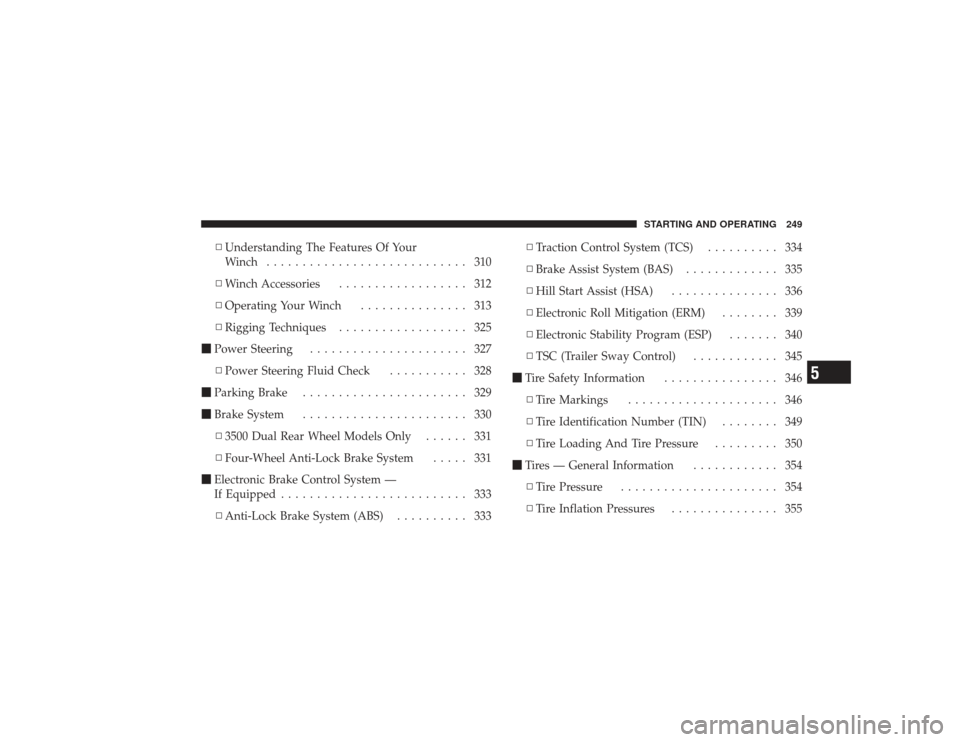
▫Understanding The Features Of Your
Winch ............................ 310
▫ Winch Accessories .................. 312
▫ Operating Your Winch ............... 313
▫ Rigging Techniques .................. 325
� Power Steering ...................... 327
▫ Power Steering Fluid Check ........... 328
� Parking Brake ....................... 329
� Brake System ....................... 330
▫ 3500 Dual Rear Wheel Models Only ...... 331
▫ Four-Wheel Anti-Lock Brake System ..... 331
� Electronic Brake Control System —
If Equipped .......................... 333
▫ Anti-Lock Brake System (ABS) .......... 333▫
Traction Control System (TCS) .......... 334
▫ Brake Assist System (BAS) ............. 335
▫ Hill Start Assist (HSA) ............... 336
▫ Electronic Roll Mitigation (ERM) ........ 339
▫ Electronic Stability Program (ESP) ....... 340
▫ TSC (Trailer Sway Control) ............ 345
� Tire Safety Information ................ 346
▫ Tire Markings ..................... 346
▫ Tire Identification Number (TIN) ........ 349
▫ Tire Loading And Tire Pressure ......... 350
� Tires — General Information ............ 354
▫ Tire Pressure ...................... 354
▫ Tire Inflation Pressures ............... 355
STARTING AND OPERATING 249
5
Page 254 of 532
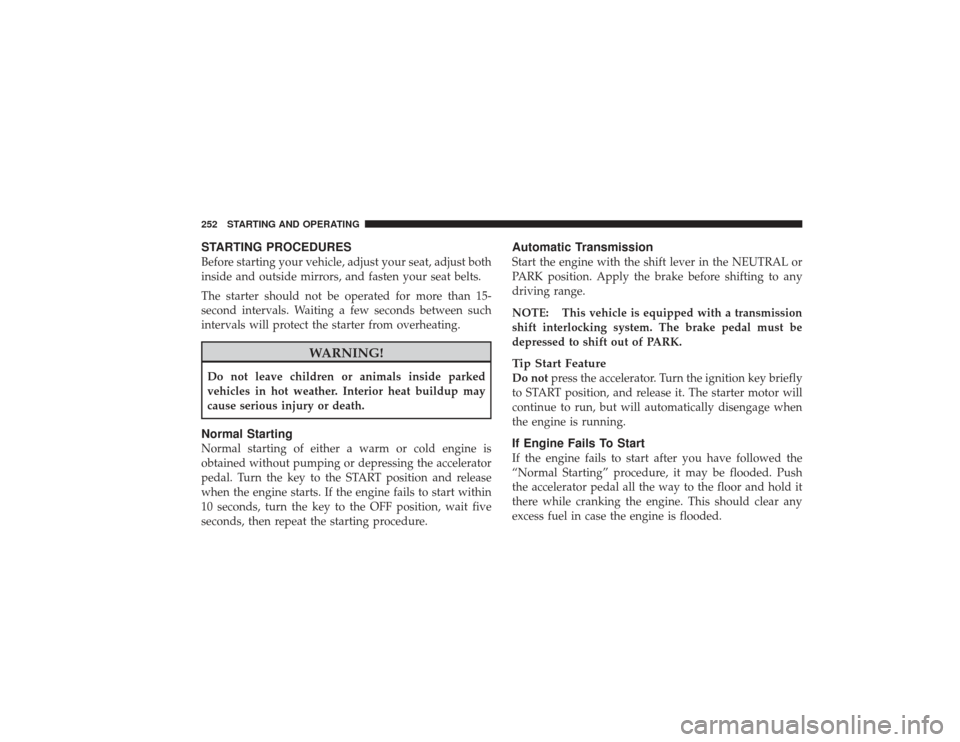
STARTING PROCEDURESBefore starting your vehicle, adjust your seat, adjust both
inside and outside mirrors, and fasten your seat belts.
The starter should not be operated for more than 15-
second intervals. Waiting a few seconds between such
intervals will protect the starter from overheating.
WARNING!
Do not leave children or animals inside parked
vehicles in hot weather. Interior heat buildup may
cause serious injury or death.Normal StartingNormal starting of either a warm or cold engine is
obtained without pumping or depressing the accelerator
pedal. Turn the key to the START position and release
when the engine starts. If the engine fails to start within
10 seconds, turn the key to the OFF position, wait five
seconds, then repeat the starting procedure.
Automatic TransmissionStart the engine with the shift lever in the NEUTRAL or
PARK position. Apply the brake before shifting to any
driving range.
NOTE: This vehicle is equipped with a transmission
shift interlocking system. The brake pedal must be
depressed to shift out of PARK.Tip Start FeatureDo notpress the accelerator. Turn the ignition key briefly
to START position, and release it. The starter motor will
continue to run, but will automatically disengage when
the engine is running.If Engine Fails To StartIf the engine fails to start after you have followed the
“Normal Starting” procedure, it may be flooded. Push
the accelerator pedal all the way to the floor and hold it
there while cranking the engine. This should clear any
excess fuel in case the engine is flooded.
252 STARTING AND OPERATING
Page 256 of 532
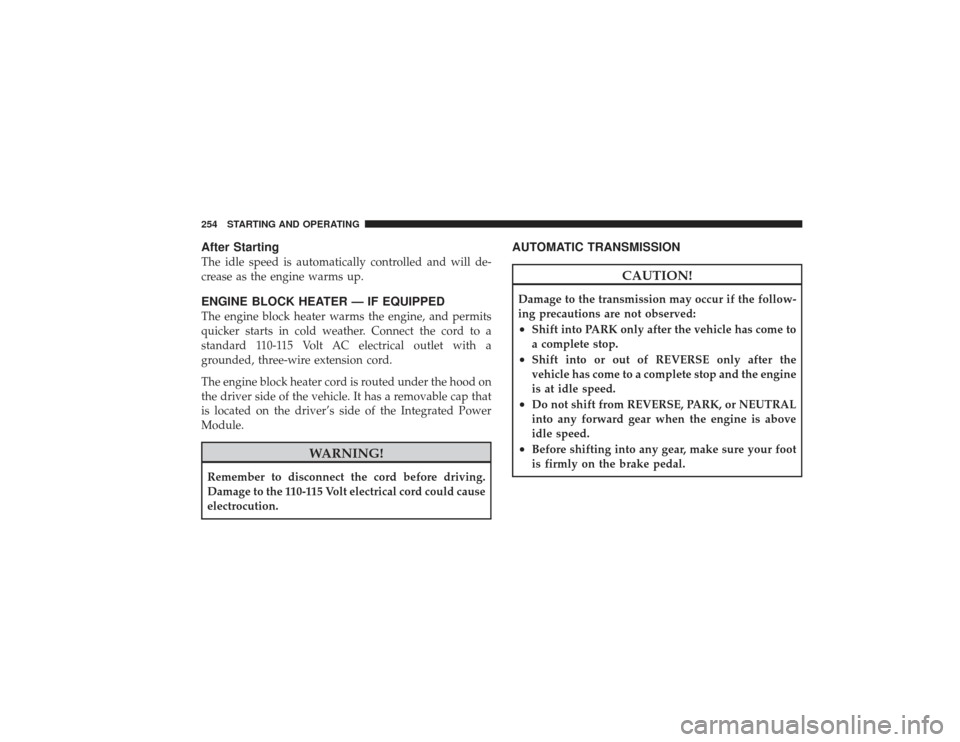
After StartingThe idle speed is automatically controlled and will de-
crease as the engine warms up.ENGINE BLOCK HEATER — IF EQUIPPEDThe engine block heater warms the engine, and permits
quicker starts in cold weather. Connect the cord to a
standard 110-115 Volt AC electrical outlet with a
grounded, three-wire extension cord.
The engine block heater cord is routed under the hood on
the driver side of the vehicle. It has a removable cap that
is located on the driver’s side of the Integrated Power
Module.
WARNING!
Remember to disconnect the cord before driving.
Damage to the 110-115 Volt electrical cord could cause
electrocution.
AUTOMATIC TRANSMISSION
CAUTION!
Damage to the transmission may occur if the follow-
ing precautions are not observed:•
Shift into PARK only after the vehicle has come to
a complete stop.
•
Shift into or out of REVERSE only after the
vehicle has come to a complete stop and the engine
is at idle speed.
•
Do not shift from REVERSE, PARK, or NEUTRAL
into any forward gear when the engine is above
idle speed.
•
Before shifting into any gear, make sure your foot
is firmly on the brake pedal.
254 STARTING AND OPERATING
Page 257 of 532
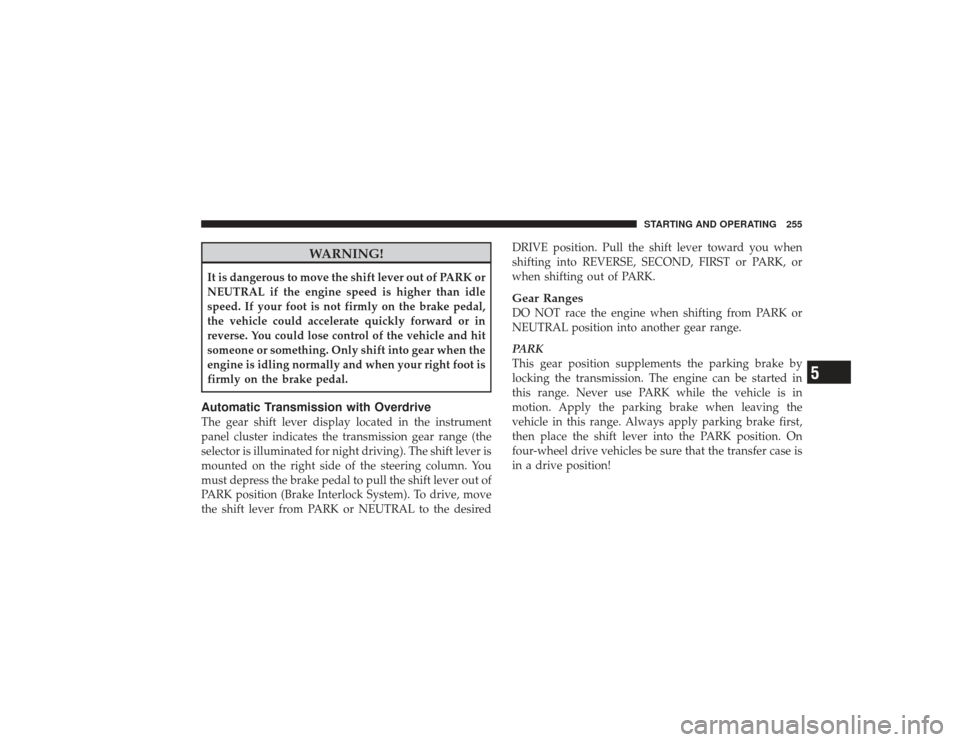
WARNING!
It is dangerous to move the shift lever out of PARK or
NEUTRAL if the engine speed is higher than idle
speed. If your foot is not firmly on the brake pedal,
the vehicle could accelerate quickly forward or in
reverse. You could lose control of the vehicle and hit
someone or something. Only shift into gear when the
engine is idling normally and when your right foot is
firmly on the brake pedal.Automatic Transmission with OverdriveThe gear shift lever display located in the instrument
panel cluster indicates the transmission gear range (the
selector is illuminated for night driving). The shift lever is
mounted on the right side of the steering column. You
must depress the brake pedal to pull the shift lever out of
PARK position (Brake Interlock System). To drive, move
the shift lever from PARK or NEUTRAL to the desiredDRIVE position. Pull the shift lever toward you when
shifting into REVERSE, SECOND, FIRST or PARK, or
when shifting out of PARK.
Gear RangesDO NOT race the engine when shifting from PARK or
NEUTRAL position into another gear range.
PARK
This gear position supplements the parking brake by
locking the transmission. The engine can be started in
this range. Never use PARK while the vehicle is in
motion. Apply the parking brake when leaving the
vehicle in this range. Always apply parking brake first,
then place the shift lever into the PARK position. On
four-wheel drive vehicles be sure that the transfer case is
in a drive position!
STARTING AND OPERATING 255
5
Page 263 of 532
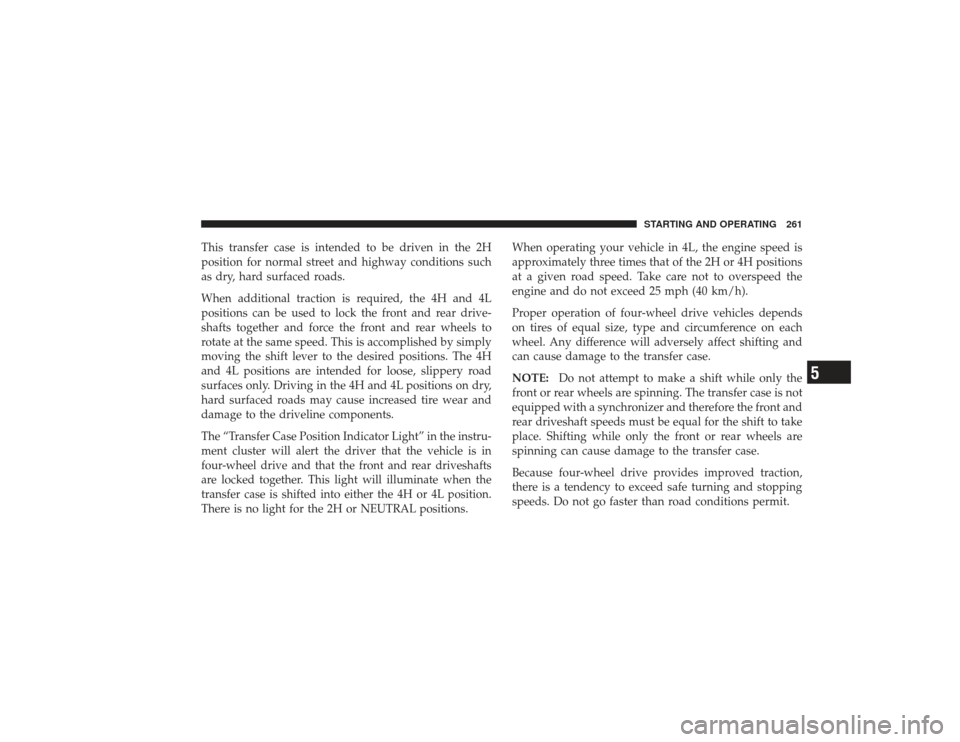
This transfer case is intended to be driven in the 2H
position for normal street and highway conditions such
as dry, hard surfaced roads.
When additional traction is required, the 4H and 4L
positions can be used to lock the front and rear drive-
shafts together and force the front and rear wheels to
rotate at the same speed. This is accomplished by simply
moving the shift lever to the desired positions. The 4H
and 4L positions are intended for loose, slippery road
surfaces only. Driving in the 4H and 4L positions on dry,
hard surfaced roads may cause increased tire wear and
damage to the driveline components.The “Transfer Case Position Indicator Light” in the instru-
ment cluster will alert the driver that the vehicle is in
four-wheel drive and that the front and rear driveshafts
are locked together. This light will illuminate when the
transfer case is shifted into either the 4H or 4L position.
There is no light for the 2H or NEUTRAL positions.
When operating your vehicle in 4L, the engine speed is
approximately three times that of the 2H or 4H positions
at a given road speed. Take care not to overspeed the
engine and do not exceed 25 mph (40 km/h).
Proper operation of four-wheel drive vehicles depends
on tires of equal size, type and circumference on each
wheel. Any difference will adversely affect shifting and
can cause damage to the transfer case.
NOTE:Do not attempt to make a shift while only the
front or rear wheels are spinning. The transfer case is not
equipped with a synchronizer and therefore the front and
rear driveshaft speeds must be equal for the shift to take
place. Shifting while only the front or rear wheels are
spinning can cause damage to the transfer case.
Because four-wheel drive provides improved traction,
there is a tendency to exceed safe turning and stopping
speeds. Do not go faster than road conditions permit.
STARTING AND OPERATING 261
5
Page 264 of 532
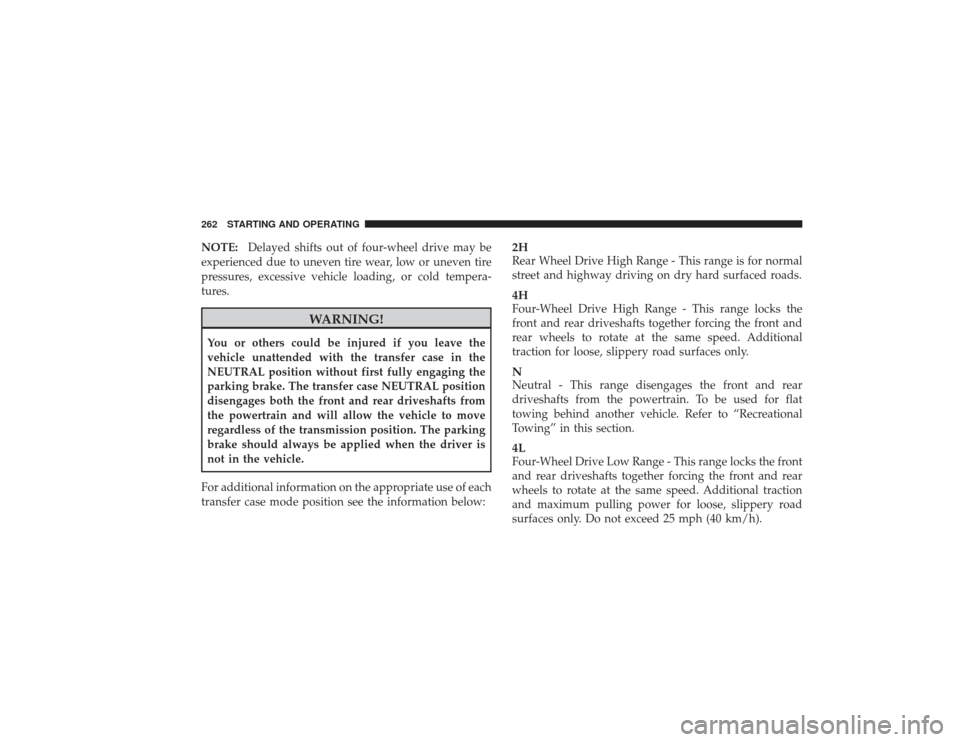
NOTE:Delayed shifts out of four-wheel drive may be
experienced due to uneven tire wear, low or uneven tire
pressures, excessive vehicle loading, or cold tempera-
tures.
WARNING!
You or others could be injured if you leave the
vehicle unattended with the transfer case in the
NEUTRAL position without first fully engaging the
parking brake. The transfer case NEUTRAL position
disengages both the front and rear driveshafts from
the powertrain and will allow the vehicle to move
regardless of the transmission position. The parking
brake should always be applied when the driver is
not in the vehicle.
For additional information on the appropriate use of each
transfer case mode position see the information below:
2HRear Wheel Drive High Range - This range is for normal
street and highway driving on dry hard surfaced roads.4HFour-Wheel Drive High Range - This range locks the
front and rear driveshafts together forcing the front and
rear wheels to rotate at the same speed. Additional
traction for loose, slippery road surfaces only.NNeutral - This range disengages the front and rear
driveshafts from the powertrain. To be used for flat
towing behind another vehicle. Refer to “Recreational
Towing” in this section.4LFour-Wheel Drive Low Range - This range locks the front
and rear driveshafts together forcing the front and rear
wheels to rotate at the same speed. Additional traction
and maximum pulling power for loose, slippery road
surfaces only. Do not exceed 25 mph (40 km/h).
262 STARTING AND OPERATING